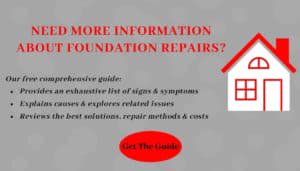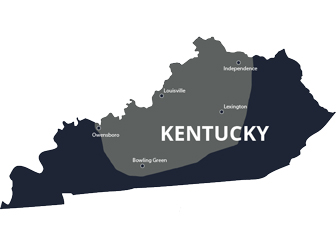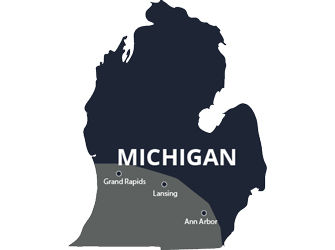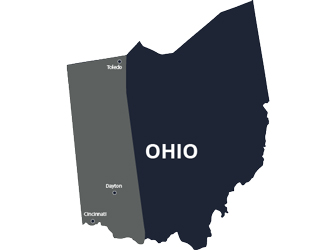Originally posted 2/4/2019; revised 5/14/2021
Sure, if there’s a puddle of water in your basement, or a long narrow crack in your foundation wall, you’re going to notice. These are the sort of symptoms you’re going to find and say to yourself, “I have a foundation issue.”
But what if the symptoms aren’t so obvious? Not all foundation problems start off as large, resounding alarms; sometimes it can be a little thing that eventually becomes a big thing.
Acculevel has been in the foundation repair business for a long time. Andy Beery started the company in 1996 with one goal: to help people protect and preserve their homes. So far, we’ve helped more than 30,000 homeowners throughout our service area do just that.
In this blog, we’re going to describe seven warning signs- both large and small- that indicate you need to have your foundation inspected by a professional.
1. Let’s Start with Smell
It sounds kind of silly- maybe a bit trivial- but what you smell is important. Look around your house. Do you have candles, wax warmers, or other scented products in every room? Have you given the dog a bath, checked your kids’ rooms for dirty gym clothes, cleaned out the fridge, and still there’s an odor that makes your nose itch? That could be mold.
Walk downstairs into your basement- or open the crawl space access- and take a few deep breaths. If you smell musty, stale, damp air, that is an indication that you have some kind of biological growth in your home.
There are a number of health concerns related to mold, mildew, and other types of growth. It’s especially bad for infants, children, and people of any age with allergies, asthma or respiratory disease. But mold is also a warning because it needs moisture to develop.
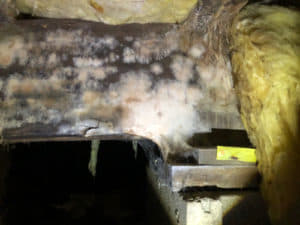 This photo was taken by an Acculevel project manager during a free estimate appointment. A thick layer of mold is growing on the decaying floor joist and support column.
This photo was taken by an Acculevel project manager during a free estimate appointment. A thick layer of mold is growing on the decaying floor joist and support column.
2. Sagging Floors
You’re probably aware that water in your basement or crawl space is an immediate sign that something is wrong, and your home needs attention. But it doesn’t have to be literal standing water to become a problem.
Too much moisture or humidity creates a damp environment; that is enough to cause the wooden components of your flooring structure to soften or rot. This can bring in a new problem for you: insects. Termites don’t want clean, dry wood because it’s hard to break down. But wood that is already softened by moisture? It’s just what those destructive pests are looking for.
Most homeowners don’t go into their crawl space regularly. So, aside from a nasty smell, how do you know you have a moisture problem? Your floors will tell you.
Moisture causes wood to decay, and that includes the lumber used to build your flooring structure. The joists, main beam, sill plate, subfloor- all of these are wooden components that will break down. If your floor is starting to dip, slope to the outside, or sag in the middle? You have a moisture problem in your crawl space.
3. Standing Water
Water in your basement or crawl space is a clear and obvious warning sign. Not only because water damages everything you have in that area of your home, but because water indicates that you have a crack or leak somewhere in your foundation. (In a crawl space, the water could come up directly through the dirt floor, also.)
Many times, cracks that leak water are an indication that hydrostatic pressure has formed and is pushing against your foundation. This pressure is created by an excess of water in the soil; the soil can’t absorb it all, so the moisture collects and pushes against your home.
For you as a homeowner, this can mean two types of repair. The first one is obvious: the crack needs to be repaired, to keep it from leaking water again. Acculevel strongly recommends using an epoxy repair method; we believe it is the most effective and longest-lasting option available right now.
 This photo was taken by an Acculevel project manager during a free estimate appointment. Water has been seeping in through cracks, causing biological growth to form.
This photo was taken by an Acculevel project manager during a free estimate appointment. Water has been seeping in through cracks, causing biological growth to form.
The second is less intuitive, and many homeowners shy away from the added expense. But waterproofing is often needed to address the hydrostatic pressure. If you don’t, when the pressure builds up it may create new crack(s) and cause you the same issue again and again. A good waterproofing system will relieve the pressure and protect your foundation’s integrity. Because when water entering your foundation has a path designed for it, the drainage system is in control. The water enters your basement or crawl space where the water drainage can capture it and direct it to a sump pump. This pump then removes the water from your basement through a drainage line.
Left unchecked, hydrostatic pressure can create significant damage to your home.
4. Bowing Walls
If you don’t get interior foundation cracks repaired, hydrostatic pressure will force them to widen over time. If those cracks are left unresolved for long enough, you can end up with a leaning or bowing wall. This is a major cause for alarm. Once a foundation wall begins to bow, the stability of that wall is compromised. This should be fixed as soon as you discover it is happening. We discuss why repairing a bowing wall is urgent in greater detail here.
In brief, however, what comes down to is the safety and stability of your home. Once a weak point has formed, it needs to be reinforced or it will only get worse. There are two types of interior cracks that are a clear and distinct indication your wall is at risk.
- The first is a long horizontal crack in the wall. This can be found in your foundation wall, whether that foundation is made of poured concrete or cinder block.
- The second only develops in the interior foundation wall if it’s made of block. This one is most often referred to as a stair-step, but it can also be called a zig zag pattern.
 This photo was taken by an Acculevel project manager. Both types of interior foundation crack are clear and distinct.
This photo was taken by an Acculevel project manager. Both types of interior foundation crack are clear and distinct.
When you have a damaged wall like this, there’s more than one way to repair it. The best repair method for a bowing wall depends on how severely it is bowing.
5. Exterior Cracks
I think one of the more confusing signs of foundation damage is outside foundation cracks. In the last section, we discussed how a zig zag pattern on the interior means the wall is bowing.
But a stair-step crack on the exterior of your foundation means something completely different. In those cases, it’s caused by a settling problem.
 This photo was taken by an Acculevel team member, after helical piers were installed. You can see the stair-step cracks have been closed and repaired.
This photo was taken by an Acculevel team member, after helical piers were installed. You can see the stair-step cracks have been closed and repaired.
Settling can be a misnomer, I think. All homes settle over time, as the weight of the building presses down into the soil below it. But sometimes, one corner or section of the foundation settles faster than the others, and throws the base of the home out of step. (You need piers to repair settling; additional info is in section #7.)
The section that settles faster will pull at the other sections. It’s kind of like a cartoon, when a person is trying to walk a large dog on a leash. If the dog sits down and won’t get up, the leash tightens and stretches, until the person gets pulled back towards him. Except your home is not as flexible as a leash. Concrete, wood, and steel are not meant to stretch, so when that cracked wall pulls hard? Cracks form- and not just on the exterior of the foundation.
6. Drywall Cracks
Uneven settling, as I just described, can create cracks in locations other than in your foundation. This is because drywall isn’t any more elastic than the wood or concrete in your home.
This isn’t to say that every drywall crack means a settling issue is developing. For example, if the crack runs in a straight line, it could simply be a poorly covered seam in the drywall. On some occasions, drywall cracks can be caused by sagging floors (more info in section #2).
But if you have cracks forming around doors or windows like the one below? This is a common symptom of uneven settling.
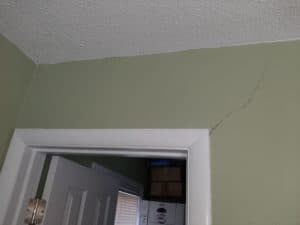 This photo was taken by an Acculevel project manager during a free estimate appointment. The drywall crack running from the door frame towards the ceiling is an indication of settling.
This photo was taken by an Acculevel project manager during a free estimate appointment. The drywall crack running from the door frame towards the ceiling is an indication of settling.
These spidery cracks can sometimes be found in the ceiling, as pictured below. (This photo was also taken by an Acculevel project manager.)

If siding covers the outside of your house and keeps you from easily viewing your exterior foundation? These interior drywall cracks may be your most visible signs to watch.
7. Windows and Doors
If you’ve noticed any of the drywall cracks pictured in the last section, it’s time to test the doors and windows in that area. People often describe a settling issue as “sticking” doors or windows, but I think sticking narrows it down too far.
What you’re actually trying to determine is if there’s any strain or pressure on the frame of the door or window. If a portion of your foundation is pulling against the rest of the house, it’s going to cause the wood casements to twist or warp. So wherever you see a drywall crack, test the door/window. Does it open easily? Stay open until you close it? Does it close and latch as it should? Anything that indicates the door or window no longer fits the opening properly is an indication of settling.
So let’s say you have some or all of these symptoms of settling- what now? The best method for restoring stability to your foundation is by using helical piers.
Do You Need More Information about Foundation Repairs?
We have a detailed guide to foundation repair that is designed to be a long-term resource for homeowners. I strongly encourage you to bookmark this webpage, and refer back to it whenever you have questions about your home’s health and stability.
The guide is broken down into sections, which allows you to either read from the beginning or skip ahead to the topic you need. We thoroughly discuss causes, warning signs, repair methods, costs, and potential concerns.
If You Need Foundation Repairs, Now:
Please find an experienced and well-respected foundation repair company in your area. Not sure how to do this? We have a blog that explores how to find a contractor, here.
Not sure what to ask a contractor before hiring one? Use our free guide to questions to ask a contractor.
If you live in our service area, please contact Acculevel. We will inspect your home and foundation, provide you with a whole-home solution, and a written estimate that clearly explains which service(s) we recommend and what the total cost would be (no hidden fees, here).




